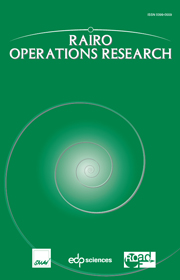No CrossRef data available.
Article contents
A hybrid genetic algorithm for a dynamic logistics network with multi-commodities and components
Published online by Cambridge University Press: 22 September 2011
Abstract
Various topics related to reverse logistics have been discussed over the years. Most of them have assumed that facilities are kept open once they are established, and no returned products or recovery parts are stocked in intermediate recycling stations. However, firms may have the right to repeatedly open or close their facilities according to their economic benefits if they can acquire their facilities by lease. It also turns out that intermediate recycling stations like collection centers and disassembly centers usually stock returned products or parts in their facilities. By simultaneously relaxing these two assumptions, this study explores a logistics system with multiple items, each of which consists of some components among a variety of spare parts. The purpose is to maximize the total logistics costs by establishing a production schedule and reverse logistics framework over finite time periods for a logistics system. The mathematical model established in this study is a constrained linear integer programming problem. A genetic based algorithm is developed with the help of linear programming to find solutions to this problem. Limited computational experiments show that the proposed approach can produce better feasible solutions than the well-known CPLEX 10.0 software.
Keywords
- Type
- Research Article
- Information
- Copyright
- © EDP Sciences, ROADEF, SMAI, 2011


